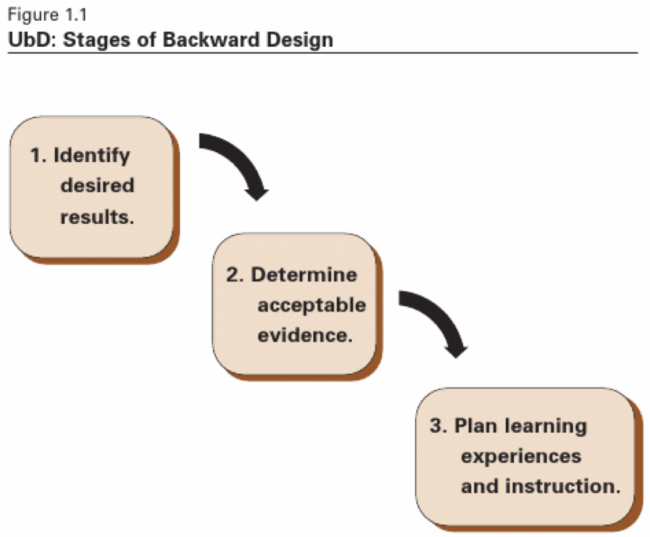CS471: Computer Science Pedagogy - Understanding by Design
Activity Goals
The goals of this activity are:- To utilize the Understanding by Design Framework in Lesson Design
Supplemental Reading
Feel free to visit these resources for supplemental background reading material.The Activity
Directions
Consider the activity models and answer the questions provided. First reflect on these questions on your own briefly, before discussing and comparing your thoughts with your group. Appoint one member of your group to discuss your findings with the class, and the rest of the group should help that member prepare their response. Answer each question individually from the activity, and compare with your group to prepare for our whole-class discussion. After class, think about the questions in the reflective prompt and respond to those individually in your notebook. Report out on areas of disagreement or items for which you and your group identified alternative approaches. Write down and report out questions you encountered along the way for group discussion.Guiding Questions
- What is the goal of the UbD framework?
- Is the UbD framework better suited to a single lesson or to a unit, and why?
- Consider teaching a unit of lessons on binary number encoding. How would you plan this into the three stages of UbD?
Model 1: The Stages of the UbD Framework

Questions
- Why do you think the UbD framework promotes "backwards design"? Why not plan your lessons, and then your assessments, and then the class activities?
- What should you do if you find that you have "too many" big ideas identified in Stage 1? How might you prioritize them?
- What are some class activities, assignments, or projects you have encountered in school that might work toward demonstrating competence in Stage 2? Can you recall a particularly well-matched or poorly-matched assessment from your own life?
- What is your favorite classroom activity format? Do you prefer lecture, or flipped classroom, or guided inquiry, or class discussions, etc.? What is the benefit of using a blend of activities rather than a single approach?
Understanding by Design: A Pedagogy Background
Understanding by Design (UbD) is an instructional framework that aims to enhance student learning by focusing on the development of deep understanding and long-term retention of knowledge. We will explore UbD, including its key principles, structure, and practical applications. In addition to summarizing the foundational readings on UbD and Bloom’s Taxonomy, this report incorporates relevant scholarly articles and research papers to offer a comprehensive understanding of this pedagogy background.
Understanding by Design (UbD)
Understanding by Design, commonly referred to as UbD, is an approach to instructional design developed by Jay McTighe and Grant Wiggins. It emphasizes the importance of framing teaching and learning processes around desired learning outcomes and essential questions.
Key Principles of UbD
UbD is guided by three interrelated principles:
-
Backward Design: UbD advocates for the reverse planning of instruction. This entails starting with identifying desired learning outcomes and then designing assessments and learning activities aligned with those outcomes. The backward design approach ensures that instruction is purposeful and focused on achieving specific goals.
-
Understanding-focused: UbD places a strong emphasis on fostering deep understanding among students. Rather than merely covering content, UbD aims to promote meaningful learning by helping students make connections, transfer knowledge to new contexts, and apply their understanding to real-world situations.
-
Authentic Assessment: UbD encourages the use of authentic assessments that mirror real-life scenarios and require higher-order thinking. This approach enables students to demonstrate their understanding in practical and meaningful ways, moving beyond rote memorization and recall.
Structure and Components of UbD
UbD is organized into a three-stage framework:
-
Stage 1: Identify Desired Results: In this stage, educators identify the desired learning outcomes and essential questions that will guide the instructional design. This involves identifying the knowledge, skills, and understandings students should acquire by the end of the unit or course.
-
Stage 2: Determine Acceptable Evidence: Once the desired results are established, educators determine the appropriate assessments and performance tasks that will provide evidence of students’ understanding. These assessments should align with the desired outcomes and promote critical thinking and application of knowledge.
-
Stage 3: Plan Learning Experiences and Instruction: The final stage involves designing the specific learning experiences, activities, and lessons that will help students achieve the desired outcomes. Educators must ensure that these instructional methods facilitate deep understanding and address students’ diverse needs.